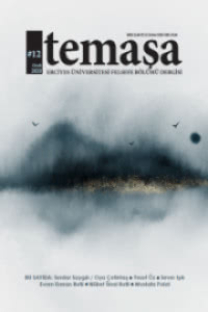Aletik Bağıntılar Işığında Mantık Eklemlerinin Anlamları
Mantıksal sabitlerin, özellikle de doğruluk fonksiyonları mantığındaki önerme eklemlerinin, anlamlarını nereden aldıkları 20. yüzyıl mantık ve dil felsefesi tartışmalarında merkezde yer alan bir sorudur. Bir ekleme özgü temel çıkarım kurallarıyla o eklemin anlamı arasında nasıl bir belirleme/haklılaştırma bağıntısı bulunur? Bu kurallar ilgili eklemin anlamı yoluyla mı haklılaştırılır, yoksa o anlamın belirlenişine mi katılırlar? 1930’larda modern kanıt kuramsal yaklaşımın temellerini atan G. Genzten’in yaptığı bir saptama, anılan soruya dikkat çekici bir yanıt oluşturan (bazılarının mantıksal çıkarımsalcılık olarak andığı) şu görüşü tetiklemiştir: Mantık dilindeki bir mantıksal sabitin anlamı, bir çeşit temsil içeriği tarafından değil, onun kullanımını idare eden çıkarım normları tarafından sağlanır. Arthur N. Prior 1960 tarihli ünlü yazısında bu yaklaşıma bir karşı-örnek olarak, salt çıkarım kuralları yoluyla, türetim sistemini altüst eden tonk eklemini kurgular; Nuel Belnap’ın Prior’a da yanıt oluşturan tonk sorunu çözümlemesi ise kapıyı, önemli sonuçları olan mantık-dil felsefesi tartışmalarına açar. Elinizdeki küçük çalışma, tonk sorununu, daha serbest bir çıkarımsalcı bakışla biraz daha söndürme girişimi olarak düşünülebilir. Çalışmanın iki ana savı, (i) tonk-vari eklemlerin yol açtığı sorunun, Belnap’ın (haklı) çözümlemesindekinden belki daha yalın bir şekilde, aletik bağıntılar olarak adlandıracağımız, belli tipte çıkarımsal bağıntılar yoluyla yakalanabileceği; ve (ii) Prior’ın itirazının, hangi şekilde tamamlanırsa tamamlansın, çıkarımsalcı anlayış aleyhine bir sonuç üretemediğidir.
Anahtar Kelimeler:
Önerme Eklemleri, Tonk, Anlam, Aletik Bağıntılar, Çıkarım Kuralları, Mantıksal Çıkarımsalcılık
Meanings of Logical Connectives in the Light of Alethic Relations
One of the central questions in 20th-century discussions within logic and philosophy of language is where logical constants, specifically propositional connectives, get their meaning from. What kind of determination/justification bond is found between the inference rules peculiar to a given connective and the meaning of that connective? Are these rules justified by it, or rather do they contribute to its construction? An observation made by G. Gentzen, who founded in the 1930s the proof-theoretical approach at large, triggered a view (called by some logical inferentialism) that gives a remarkable answer to the above question: the meaning of a logical constant in a logical language is provided, not by some sort of representational content, but by the inferential norms that govern its overall use. In 1960 A. N. Prior fictionalized as a counter-instance the connective tonk solely using a couple of inference rules, a connective capable of overthrowing the system of deduction; N. Belnap’s 1962 reply in the form of an analysis of the tonk problem opens the way to discussions in logic-cum-philosophy of language with important outcomes. The present little study can be read as some further deflation of the tonk problem with a relatively unconstrained inferentialistic view of the matter. The two main theses of the study are (i) that the problem posed by tonk-like connectives can be captured, more simply than in Belnap’s (otherwise correct) analysis, through inferential relations of a certain type which will be dubbed alethic relations; and (ii) that Prior’s challenge, brought to completion in whichever way, cannot give any result against the inferentialist conception.
Keywords:
Propositional Connectives, Tonk, Meaning, Alethic Relations, Inference Rules, Logical Inferentialism,
___
- Belnap, N. “Tonk, Plonk and Plink,” Analysis 22, no. 6 (1962): 130-34.
- Brandom, Robert. Articulating Reasons: An Introduction to Inferentialism. Cambridge (Mass.): Harvard University Press, 2000.
- Brandom, Robert. Making It Explicit: Reasoning, Representing, and Discursive Commitment. Cambridge (Mass.): Harvard University Press, 1994.
- Corcoran, John (ed.). Ancient Logic and its Modern Interpretations: Proceedings of Buffalo Symposium on Modernist Interpretations of Ancient Logic, 21 and 22 April, 1972. Dordrecht: D. Reidel Publishing, 1974.
- Garson, James. What Logics Mean: From Proof Theory to Model-Theoretic Semantics. New York: Cambridge University Press, 2013.
- Horwich, Paul. Reflections on Meaning. New York: Oxford University Press, 2005.
- Jaskowski, Stanislaw. On the Rules of Supposition in Formal Logic. Series Studia Logica: Wydawnictwo Poswiecone Logice i jej Historii, ed. by Jan Lukasiewicz, no.1. Warsaw: The Philosophical Seminary of the Faculty of Mathematics and Natural Sciences, Warsaw University, 1934.
- Mancosu, Paolo, Sergio Galvan and Richard Zach. An Introduction to Proof Theory: Normalization, Cut-Elimination, and Consistency Proofs. Oxford: Oxford University Press, 2021.
- Pelletier, Francis J. and Allen Hazen. “Natural Deduction Systems in Logic,” The Stanford Encyclopedia of Philosophy (Spring 2023 Edition), Eds.: Edward N. Zalta & Uri Nodelman (eds.). https://plato.stanford.edu/archives/spr2023/entries/natural-deduction/
- Peregrin, Jaroslaw. Inferentialism: Why Rules Matter. London: Palgrave-Macmillan, 2014.
- Prior, Arthur N. “The Runabout Inference-Ticket,” Analysis 21, no. 2 (Dec. 1960): 38-39.
- Restall, Greg. An Introduction to Substructural Logics. New York: Routledge, 1999.
- Schroeder-Heister, Peter. “Proof-Theoretic Semantics,” The Stanford Encyclopedia of Philosophy (Fall 2023 Edition), Edward N. Zalta & Uri Nodelman (eds.). https://plato.stanford.edu/archives/fall2023/entries/proof-theoretic-semantics/
- Stevenson, J. T. “Roundabout the Runabout Inference-Ticket,” Analysis 21, no. 6 (Jun. 1961): 124-128.
- Suppes, Patrick. Introduction to Logic. Princeton (NJ): Van Nostrand/Reinhold Press, 1957.
- Szabo, M. E. (ed.). The Collected Papers of Gerhard Gentzen. Amsterdam: North Holland Pub. Co., 1969.
- ISSN: 2148-371X
- Yayın Aralığı: Yılda 2 Sayı
- Başlangıç: 2014
- Yayıncı: Prof. Dr. Arslan Topakkaya / Erciyes Üniversitesi Felsefe Bölümü
Sayıdaki Diğer Makaleler
Tüketim Kültürü Ekseninde Estetik Algısı
Burak KAHRAMAN, Rumeysa CIRDI, Funda ASLAN, Yadigar Naciye YASAN, Müşerref ÇETİNKAYA
Varoluşun Onto-Teolojisi ve Varoluşsal Tasviri
Ebü’l Hasan el-Âmirî’nin İlimler Sınıflaması
John Rogers Searle’ün “Deontik Güç” Kavramı
Thomas Hobbes’un Felsefesinde Din-Devlet İlişkisi: Din Devletinden Devlet Dinine
Geleneksel Eğitim ile Çevrimiçi Eğitimin Felsefi Bağlamda Analizi
İbn Haldûn Düşüncesi ve Liberal Görüşler Arasında Mukayeseli Bir Değerlendirme
Edward Said: Hümanizmi Evcilleştirmek
Sühreverdî ve Şehrezûrî’de Tenasühe Dair Düşünceler
Mehmet DURAN, Ahmet Kamil CİHAN
